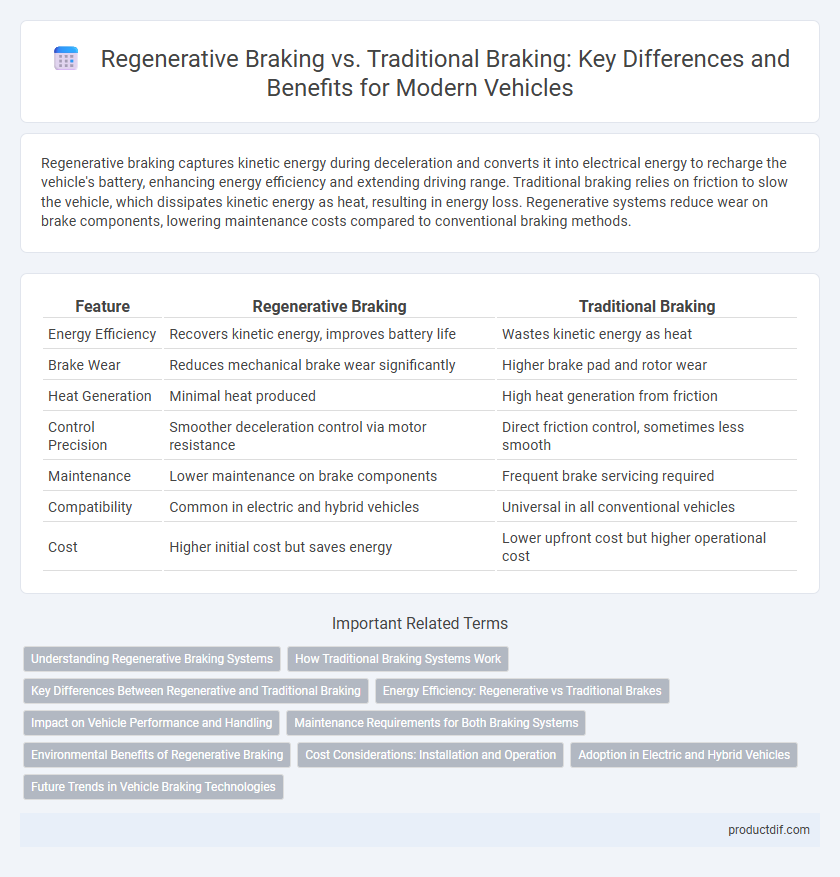Regenerative braking captures kinetic energy during deceleration and converts it into electrical energy to recharge the vehicle's battery, enhancing energy efficiency and extending driving range. Traditional braking relies on friction to slow the vehicle, which dissipates kinetic energy as heat, resulting in energy loss. Regenerative systems reduce wear on brake components, lowering maintenance costs compared to conventional braking methods.
Table of Comparison
| Feature | Regenerative Braking | Traditional Braking |
|---|---|---|
| Energy Efficiency | Recovers kinetic energy, improves battery life | Wastes kinetic energy as heat |
| Brake Wear | Reduces mechanical brake wear significantly | Higher brake pad and rotor wear |
| Heat Generation | Minimal heat produced | High heat generation from friction |
| Control Precision | Smoother deceleration control via motor resistance | Direct friction control, sometimes less smooth |
| Maintenance | Lower maintenance on brake components | Frequent brake servicing required |
| Compatibility | Common in electric and hybrid vehicles | Universal in all conventional vehicles |
| Cost | Higher initial cost but saves energy | Lower upfront cost but higher operational cost |
Understanding Regenerative Braking Systems
Regenerative braking systems capture kinetic energy during deceleration and convert it into electrical energy stored in the vehicle's battery, enhancing overall energy efficiency. Unlike traditional braking, which relies on friction to dissipate energy as heat, regenerative braking reduces wear on brake components and extends vehicle range in electric and hybrid models. These systems integrate electric motors and power electronics to optimize energy recovery without compromising braking performance.
How Traditional Braking Systems Work
Traditional braking systems function by converting kinetic energy into heat through friction between brake pads and rotors. When the brake pedal is pressed, hydraulic fluid activates the calipers to clamp the brake pads onto the spinning rotors, slowing the vehicle. This process dissipates energy as heat, leading to wear on brake components and requiring regular maintenance.
Key Differences Between Regenerative and Traditional Braking
Regenerative braking captures kinetic energy during deceleration to recharge the vehicle's battery, while traditional braking dissipates energy as heat through friction. Regenerative systems enhance energy efficiency by converting motion into electrical power, reducing wear on brake pads and improving fuel economy in electric and hybrid vehicles. Traditional braking provides consistent stopping power but lacks energy recovery capabilities, leading to increased maintenance and energy loss.
Energy Efficiency: Regenerative vs Traditional Brakes
Regenerative braking systems capture kinetic energy during deceleration and convert it into electrical energy, significantly improving energy efficiency by reducing overall fuel or battery consumption. Traditional braking systems dissipate kinetic energy as heat, resulting in energy loss and decreased efficiency. Vehicles equipped with regenerative brakes can extend driving range and lower emissions compared to those relying solely on conventional friction brakes.
Impact on Vehicle Performance and Handling
Regenerative braking enhances vehicle performance by converting kinetic energy into electrical energy, improving overall efficiency and extending battery life in electric and hybrid vehicles. Traditional braking systems rely solely on friction, which dissipates energy as heat and can lead to faster brake wear and reduced efficiency. Regenerative braking also provides smoother deceleration and reduces brake fade, positively impacting vehicle handling and driver control during repeated stop-and-go conditions.
Maintenance Requirements for Both Braking Systems
Regenerative braking systems require less frequent maintenance compared to traditional friction-based brakes due to reduced wear on brake pads and discs, as they primarily use the electric motor to decelerate the vehicle. Traditional braking systems demand regular inspections and replacements of brake pads, rotors, and hydraulic components because of continuous mechanical friction and heat generation. Vehicles equipped with regenerative braking often experience extended brake component lifespan, contributing to lower overall maintenance costs and improved durability.
Environmental Benefits of Regenerative Braking
Regenerative braking systems recover kinetic energy during vehicle deceleration, converting it into electrical energy stored in the battery, thereby reducing overall energy consumption. Unlike traditional braking that dissipates energy as heat, regenerative braking decreases brake wear and lowers greenhouse gas emissions from fossil fuel consumption. This technology enhances the environmental sustainability of electric and hybrid vehicles by improving energy efficiency and reducing reliance on non-renewable energy sources.
Cost Considerations: Installation and Operation
Regenerative braking systems typically incur higher initial installation costs due to advanced components like electric motors and sophisticated control units, whereas traditional braking systems feature lower upfront expenses with simpler mechanical parts. Over time, regenerative braking reduces operational costs by minimizing brake pad wear and recovering energy to extend battery life, leading to fuel savings or extended range in electric and hybrid vehicles. Traditional braking requires more frequent maintenance and part replacements, resulting in higher ongoing expenses despite lower installation investment.
Adoption in Electric and Hybrid Vehicles
Regenerative braking systems are increasingly adopted in electric and hybrid vehicles due to their ability to recover kinetic energy and improve overall energy efficiency, contrasting with traditional braking systems that dissipate energy as heat. This technology extends battery range by converting braking force into electrical energy, making it a critical component in modern EV and hybrid powertrains. Automakers prioritize regenerative braking integration to enhance sustainability, reduce wear on mechanical components, and optimize vehicle performance.
Future Trends in Vehicle Braking Technologies
Regenerative braking systems in electric and hybrid vehicles are rapidly evolving to improve energy recovery efficiency and extend battery life, leveraging advanced materials and control algorithms. Traditional friction braking is being enhanced with smarter integration of electronic brake force distribution and predictive maintenance systems driven by AI to improve safety and durability. Future trends emphasize seamless synergy between regenerative and conventional braking to optimize vehicle performance while reducing environmental impact.
Regenerative Braking vs Traditional Braking Infographic

 productdif.com
productdif.com